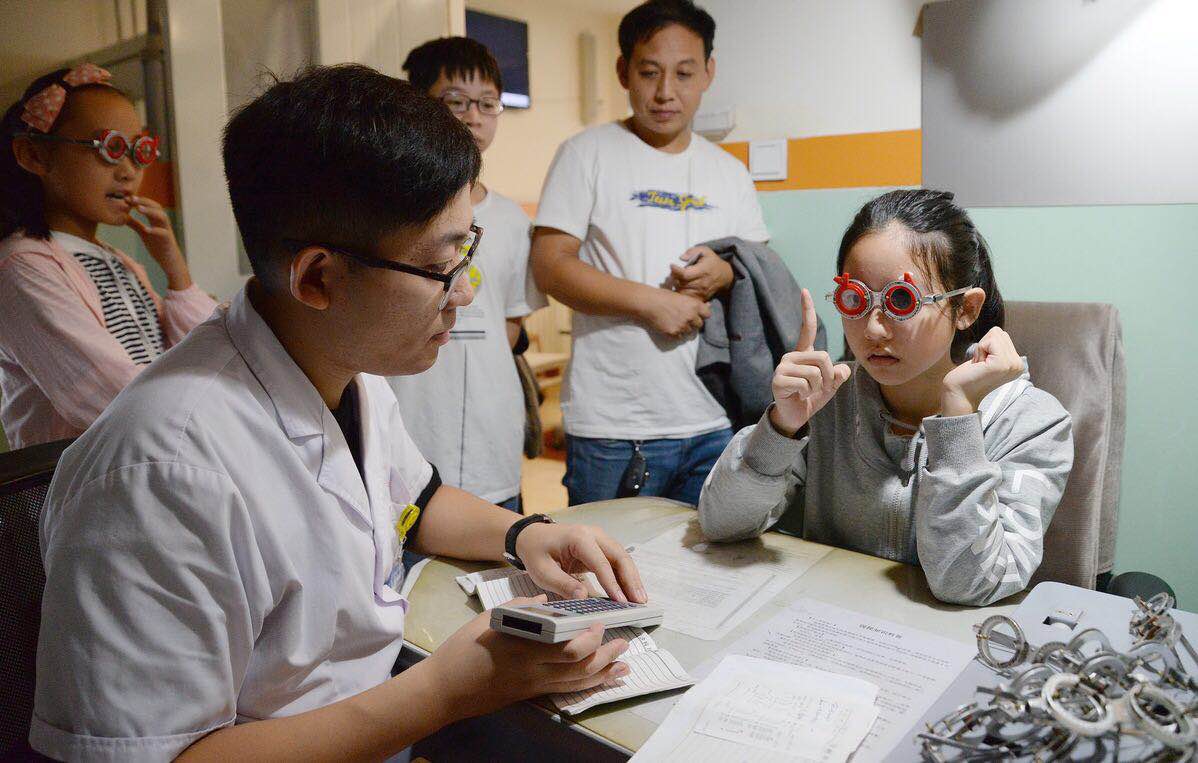


A primary school student gets a vision test in Handan, Hebei province, during the summer holiday. [Hao Qunying/For China Daily]
BEIJING -- China rolled out a new scheme Thursday to curb the rise in nearsightedness - or myopia - among children and teenagers for the sake of their health and the nation's future.
The scheme, jointly issued by the Ministry of Education, the National Health Commission and six other departments, aims to keep the myopia rate among 6-year-old kids at around 3 percent by 2030, with the incidence among primary school kids to drop below 38 percent, and the rate among junior and senior high school students to fall below 60 percent and 70 percent respectively.
The scheme also said the overall myopia rate of Chinese teenagers should be reduced by over 0.5 percent each year from 2018 to 2023. In high-incidence provinces, the reduction should reach 1 percent each year, the scheme said.
Strengthened regulation over production and selling of eyeglasses and limitation of teenagers' online gaming time are required by the scheme.
The scheme aims to greatly reduce the myopia rate among the Chinese teenagers to bring children a "bright future," as demanded by President Xi Jinping in a recent instruction.
The high incidence of myopia among students, which affects more and more children at a younger age and undermines their health, is a major problem concerning the future of the country and the Chinese nation, Xi instructed after reading a recent media report on the problem.
About 36.5 percent of the fourth graders and 65.3 percent of the eighth graders have poor eyesight, according to an MOE report released in July this year.
Another report by a health research institution under Peking University showed more than 70 percent of high school and college students were nearsighted, warning China may be short of labor with qualified eyesight in sectors like aerospace, sophisticated manufacturing and the military in the future if myopia worsens.
Increased school workloads and heavier use of electronic devices are regarded as major reasons leading to the worsening nearsightedness.
According to the MOE report, 14.7 percent of fourth-grade students and 19.2 percent of eighth-grade students on average spend over an hour everyday doing maths homework, while 43.8 percent of the fourth graders and 23.4 percent of the eighth graders take extra maths training outside classes.
The scheme encourages children to spend more time outdoors and orders schools not to leave written assignments to first and second graders.
Jiao Yahui, an NHC official, said the children and their parents need to raise their awareness to protect the eyesight for the kids.
The scheme also introduces indicators to assess the performance of local governments on their measures to control myopia of children under their jurisdictions.

 Award-winning photos show poverty reduction achievements in NE China's Jilin province
Award-winning photos show poverty reduction achievements in NE China's Jilin province People dance to greet advent of New Year in Ameiqituo Town, Guizhou
People dance to greet advent of New Year in Ameiqituo Town, Guizhou Fire brigade in Shanghai holds group wedding
Fire brigade in Shanghai holds group wedding Tourists enjoy ice sculptures in Datan Town, north China
Tourists enjoy ice sculptures in Datan Town, north China Sunset scenery of Dayan Pagoda in Xi'an
Sunset scenery of Dayan Pagoda in Xi'an Tourists have fun at scenic spot in Nanlong Town, NW China
Tourists have fun at scenic spot in Nanlong Town, NW China Harbin attracts tourists by making best use of ice in winter
Harbin attracts tourists by making best use of ice in winter In pics: FIS Alpine Ski Women's World Cup Slalom
In pics: FIS Alpine Ski Women's World Cup Slalom Black-necked cranes rest at reservoir in Lhunzhub County, Lhasa
Black-necked cranes rest at reservoir in Lhunzhub County, Lhasa China's FAST telescope will be available to foreign scientists in April
China's FAST telescope will be available to foreign scientists in April